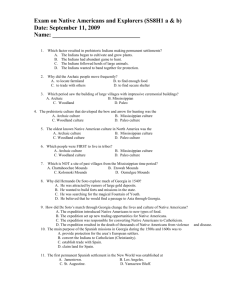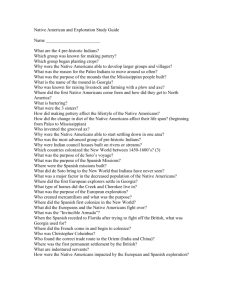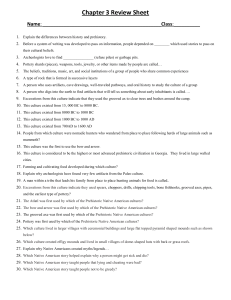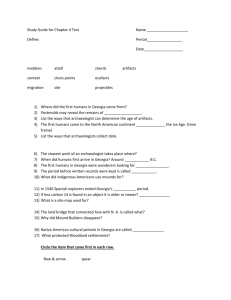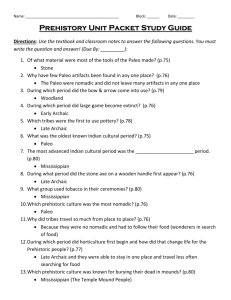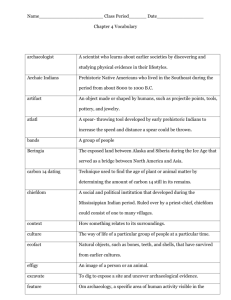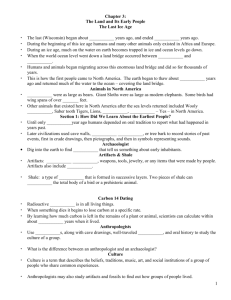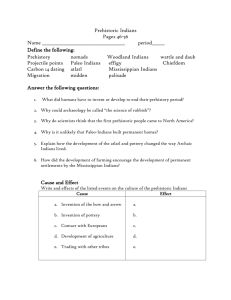early inhabitants PPT
advertisement
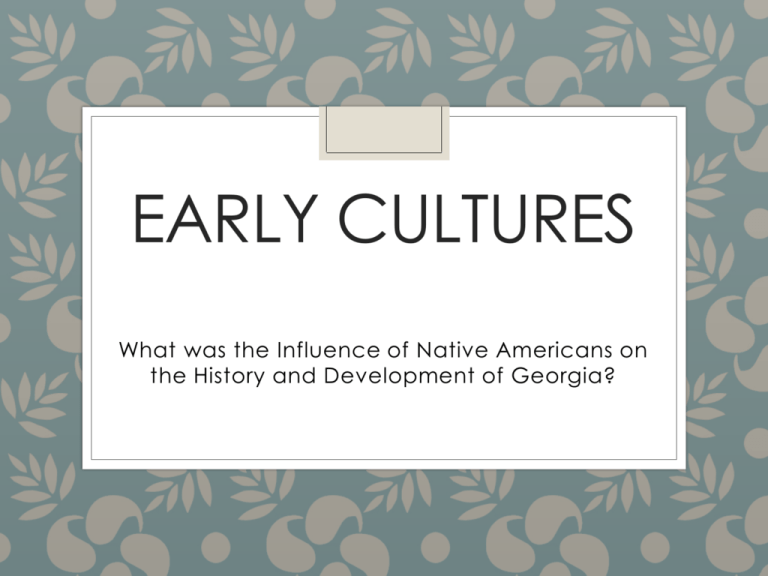
EARLY CULTURES What was the Influence of Native Americans on the History and Development of Georgia? From Where Did They Come ? ◦ Where did the people to be called “Native Americans” come from? ◦ Scientists believe that they came from Asia and crossed the Bering Straits during the last ice age. Massive glaciers removed so much water from the seas that a “land bridge” between the Asian and North American continents appeared. www.americanindian.net/ links7.html Prehistoric Indians of Georgia There were four time periods of Indian life in prehistoric Georgia: ◦ Paleo Period – 10,000 BC to 8000 BC ◦ Archaic Period – 8000 BC to 1000 BC ◦ Woodland Period – 1000 BC to 1000 AD ◦ Mississippian Period – 1000 to 1600 AD Paleo Indians 10,000 B.C. to 8000 B. C. http://www.cr.nps.gov/seac/ssteller.htm Weapons of the Paleo Indians ◦ Made from antlers and rocks ◦ Knives, spearheads, and axes ◦ Used cane or tree trunks for shafts ◦ Clovis Points were the earliest known spear points of the Paleo Indians Clovis Point ◦ These points were made from flint rocks using a technique called ‘flint knapping’. ◦ Clovis point found at Ocmulgee site in Georgia http://www.stlcc.edu/fv/users/mfuller/martens/Pottery.html Clovis Spear Points ◦ These are other examples of Clovis Points. ◦ Notice that the back of several are plain. ◦ Later Paleo Indians began to notch the ends of the points to better tie them to their spears. http://www.150.si.edu/150trav/remember/r112a.htm Paleo Food Sources ◦ Primarily ate fruit and berries ◦ Hunted large game such as the mammoth, the mastodon, giant bison, giant sloths, and other large mammals. ◦ They hunted in groups and had to get very close to their game in order to kill it (they were using spears, see picture on page 43). Wooly Mammoths ◦ Over 9 feet tall at the shoulder ◦ Over 15 feet long from tusk to tail ◦ The longest tusks found were over 17 feet in length. ◦ Heavier than the mastodons. http://www.unmuseum.org/mastodon.htm Mastodon ◦ Stood from 6 to 9 feet tall at the shoulder. ◦ Were up to 15 feet long from tusk to tail. ◦ Weighed from 4 to 6 tons. ◦ Evolved from the wooly mammoth. http://www.museum.state.il.us/exhibits/larson/mammut.html Paleo Indians Attacking a Mammoth ◦ Mammoths could weight 8,000 to 10,000 pounds. ◦ The spears used by the Paleo Indians were crude weapons, the men had to get very close to their game to kill it. They risk injury or death trying to kill one of these beasts. ◦ If injured, there were no doctors or hospitals. http://www.crt.state.la.us/crt/ocd/arch/laprehis/paleo.htm Ground Sloth ◦ The giant sloths weighed about 100 pounds. ◦ They became extinct about 10,000 years ago. ◦ Hunting pressure and environmental changes due to climate changes. http://www.museum.state.il.us/exhibits/larson/sloth.html Giant Bison ◦ They were about twice as big as our modern day buffalo. ◦ Their horns could be seven feet from tip to tip (modern buffalo will reach about 2 feet). ◦ They may have weighed as much as 4,000 pounds. http://www.sd4history.com/Unit1/giantbison.htm Shelter of the Paleo Indians ◦ Paleo Indians were nomadic, they moved from place to place, following animals they killed for food. ◦ They did not build permanent houses, but rather lived in shallow pits, rock shelters, or crude shelters covered with animal skins or tree bark. http://www.cabrillo.cc.ca.us/~crsmith/anth7_paleo.html Religion and the Paleo Indian ◦ There is only limited evidence of religious practices of the Paleo Indians living in Georgia. ◦ Two skeletons were found buried with several artifacts and covered with a red powder. ◦ This suggested that they practiced some form of burial ceremony. Lifestyle of the Paleo Indians ◦ They lived in small family groups, usually no more than 20 to 30 people per group. ◦ The family groups were small because they could not get enough food (animals they killed plus nuts and berries they gathered) to support larger numbers. ◦ They usually only lived to be 30 to 40 years old due to disease and accidental death (for example - being stepped on by a mastodon). LIVED DURING THE END OF THE ICE AGE Prehistoric Indians of Georgia There were four time periods of Indian life in prehistoric Georgia: ◦ Paleo Period – 10,000 BC to 8000 BC ◦ Archaic Period – 8000 BC to 1000 BC ◦ Woodland Period – 1000 BC to 1000 AD ◦ Mississippian Period – 1000 to 1600 AD Archaic Period Indians 8000 B.C. to 1000 B.C. ◦ FIRST CULTURE OF GEORGIA ◦ About 7000 B.C. the climate began to change. Large mammals such as the mammoth, mastodon, giant sloth, and giant bison died out. ◦ A new tradition of Native Americans, known as the Archaic Indians adapted to the warming climate of Georgia. Archaic Weapons and Tools ◦ Archaic points were more defined and often had a barb on the end. This helped hold the point on the spear shaft. ◦ The stone axe was not just used as a weapon but also used to cut down trees, hollow out holes for storage, etc. http://www.crt.state.la.us/crt/ocd/arch/laprehis/paleo.htm Weapons/Hunting Tools, Archaic Period ◦ The atlatl became the weapon of choice for the Archaic Period Indians. ◦ They still used spears to kill their game, but since the large mammals had disappeared, the spear was not as effective as a hunting tool. Atlatl (pronounced – (at/lat/l) ◦ An atlatl was a stick about two feet long with a notch on the back. ◦ It would throw a spear about six feet long. http://www.crt.state.la.us/crt/ocd/arch/laprehis/paleo.htm Animals Hunted by Archaic Indians www.bearbiology.com/bbdesc.html http://www.bcadventure.com/adventure/wilderness/animals/raccoon.htm http://www.esf.edu/pubprog/brochure/turkey/turkey.htm http://www.bowhunting.net/Scouting/default.htm Lifestyle of the Archaic Indians ◦ Small villages of people living together was possible because they used more variety in their diet, eating more vegetables. ◦ They also ate shellfish and used barbed hooks to catch fish. ◦ Grinding stones and large storage pits for food were common. http://archive.ncsa.uiuc.edu/Cyberia/RiverWeb/History/Cahokia/archaic/settle.html Archaic Indian Pottery ◦ The first use of pottery was found at the end of the Archaic Period. ◦ Pottery allowed the people to store food, cook with oils, and water. ◦ Primitive markings and symbols were used to decorate the outside of some pottery pieces. http://www.cr.nps.gov/seac/outline/04- / Evidence of Religion – Archaic Indians ◦ There is evidence that the Archaic Indians believed in life after death. ◦ They buried tools, weapons, body ornaments and food with the dead person. Lifestyles of the Archaic Indians ◦ They were the first to make fiber tempered pottery. ◦ There is evidence that they were primitive mound builders. ◦ There is evidence that they traded with other native peoples ◦ Traded bowls for utensils and tools ◦ They moved in limited areas, often spending a lifetime within a small area. ◦ They invented new ways of hunting and fishing, using barbed fishhooks and fish traps. ◦ Lived in rock shelters and pithouses Prehistoric Indians of Georgia There were four time periods of Indian life in prehistoric Georgia: ◦ Paleo Period – 10,000 BC to 8000 BC ◦ Archaic Period – 8000 BC to 1000 BC ◦ Woodland Period – 1000 BC to 1000 AD ◦ Mississippian Period – 1000 to 1600 AD Woodland/Mississippian Foods •http://www.cr.nps.gov/seac/woodland.htm http://www.funnytummy.com/posters_asst_vegetables.html http://free-stock-photos.com/food/beans.html Woodland Period Shelter ◦ Sometimes referred to as “longhouses” these were often permanent locations. ◦ Covered with tree bark or often animal skins. ◦ In the later part of the period they also used “wattle and daub” constructed houses. ◦ Wattle and daub houses were constructed from interwoven sticks and twigs and covered with mud and allowed to dry. http://www.germantown.k12.il.us/html/homes.html Lifestyle of the Woodland Woodland Indians began to build permanent settlements a long stream valleys BUILT PROTECTIVE WALLS AROUND VILLAGES AND STORAGE FACILITIES DEVELOPED AGRICULTURE maize (corn) and squash/ gourds would harvest grains, beans, Stored foods for winter and earlyhttp://archive.ncsa.uiuc.edu/Cyberia/RiverWeb/History/Cahokia/woodland/settle.html spring Woodland Period Pottery ◦ The early Woodland pottery had markings and designs which varied from area to area http://archive.ncsa.uiuc.edu/Cyberia/RiverWeb/History/Cahokia/woodland/tech.html Woodland Hunting ◦ The Woodland Indians developed the bow and arrow. ◦ It replaced the spear and atlatl as the primary hunting weapon. http://www.cr.nps.gov/seac/outline/04-woodland/ WOODLAND MOUNDS ◦Best know structures left by Woodland Indians were mounds ◦Contain skeletons, jewelry, pottery, beads ◦Several mounds in Georgia: ◦Kolomoki Mounds ◦Rock Eagle Kolomoki Mound ◦ Burial Mound at Kolomoki The largest burial mound at Kolomoki Mounds is seen here 56 foot high Temple Mound. Rock Eagle ◦ Rock Eagle effigy mound is the next oldest Indian mound site in Georgia after the Sapelo Shell Ring Complex. This Indian mound is an effigy in the shape of a bird with its wings spread. It is believed to have been constructed by a Native American group around 2,000 years ago Mounds and Indian Religious Beliefs ◦ Both Woodland Indians and Mississippian Indians believed in life after death. ◦ This was demonstrated by the great mounds they built. http://roadsidegeorgia.com/site/rock_eagle.html ◦ The effigy mound at Rock Eagle and the seven mounds built near the present city of Cartersville are examples of their skills. http://ngeorgia.com/history/early.html Prehistoric Indians of Georgia There were four time periods of Indian life in prehistoric Georgia: ◦ Paleo Period – 10,000 BC to 8000 BC ◦ Archaic Period – 8000 BC to 1000 BC ◦ Woodland Period – 1000 BC to 1000 AD ◦ Mississippian Period – 1000 to 1600 AD COMPLEX CULTURE DEVELOPED CIVILIZATION had political, social, religious structures ◦ 1. cities were centers of trade ◦ 2. specialized jobs for different people ◦ 3. organized forms of government and religion ◦ 4. system of record keeping ◦ 5. advanced tools ◦ Mississippian Indians became permanent residents of the areas due to improved agriculture: HORTICULTURALISTS ◦ Warm climate and longer growing seasons made permanent settlements possible. ◦ Villages often surrounded by wooden palisade and a moat on the outside. http://www.cr.nps.gov/seac/outline/05-mississippian/index.htm Foods Tools ◦ Deer ◦ Stone axes ◦ Turkeys ◦ Digging sticks ◦ Small animals ◦ Fire ◦ Shellfish ◦ Fish ◦ turtles ◦ Corn ◦ Beans ◦ Squash ◦ Sunflowers ◦ Nuts ◦ fruits Weapons Spears Bow and Arrows Atlatl Mississippian Period Warrior ◦ The Mississippian warrior presented a very interesting figure. ◦ Notice the tattoos on his body, meant to scare his opponents. ◦ The bow and arrow became the weapon of choice, it was accurate and could kill at great distances. ◦ The warrior would carry 15 to 20 arrows in a quaver on his back. ◦ He could fire about 4 to 5 arrows per minute in a battle situation. Mississippian Mounds & Villages ◦ The Mississippian Period Indians were prolific mound builders. ◦ The mounds were generally used for worship or for an elevated area for the chief-priest to live on. ◦ Towns had flat-topped temple mounds with ceremonial buildings/ public structures on top http://www.mississippian-artifacts.com/html/main.html ◦ Mounds stood as tall as 100 feet ◦ Were built in stages/over a century or more ◦ Various shapes/most rectangular ◦ Purposes: ◦ ◦ ◦ ◦ Platforms for buildings Stages for religious activities Stages for social activities cemeteries ◦ --------------------------------------------------------------------◦ Plaza in center of town- religious and social gathering place ◦ Houses were built around Plaza in courtyards that served the households of several related households ◦ Spent most of their lives outdoors ◦ Houses- shelters from inclement weather ◦ Rectangular or circular pole structures ◦ Walls- weaving saplings and cane around poles ◦ Sun-baked clay (daub) ◦ Roofs- thatched – small hole for smoke to escape Travels and Contacts ◦ Buildings resemble those found in Mexico and Guatemala ◦ Mississippian had to have traveled ◦ Some crops were brought back from Central America and introduced into their agriculture Lifestyle ◦ Commoners ◦ Hard labor ◦ Grew the food ◦ Made crafts ◦ Served as warriors ◦ Laborers for public work projects ◦ Elite ◦ Higher social standing ◦ Chiefs/family were descended from the sun- important god and they could influence the supernatural world / giving them the ability to influence rising of the sun, spring rains, fall harvest ◦ -Received special treatment ◦ Larger houses ◦ Special clothing and food ◦ Exempt from hard work Mississippian Period Pottery ◦ The Mississippian Indians made beautiful pottery and ceremonial and decorative pieces. ◦ They not only drew intricate figures but also used coloring such as ochre colored clays to decorate them. http://ngeorgia.com/history/early.html Art ◦ Some of the most impressive achievements of the Mississippian people are the finely crafted objects made of stone, marine shell, pottery, and native copper. ◦ Created: decorative collar pieces, cups, pendants, and beads made of marine shells/many with elaborate designs One of the Etowah Mounds Found at Cartersville, Georgia http://ngeorgia.com/parks/etowah.html End of the Mississippian Era ◦ Indians that Hernando de Soto encountered when he began to explore Georgia in 1540. FIRST GROUP TO BE DEVASTATED BY VIOLENCE & INFECTIOUS DISEASES BROUGHT BY EUROPEANS (measles, tuberculosis, smallpox) ◦ Survivors became the Creek and Cherokee Indian tribes- played such an influential role in development of Georgia history.
